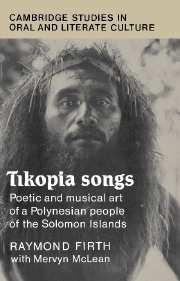Book contents
- Frontmatter
- Contents
- ILLUSTRATIONS
- FIGURES
- Preface
- Acknowledgements
- Sketch map of Tikopia (approx. 5 sq. km.)
- Part I General
- 1 The nature of Tikopia song
- 2 Tikopia poetic language and imagery
- 3 Funeral and mourning as musical occasions
- 4 Dance and song
- Part II Musical analysis (by Mervyn McLean)
- Part III Song texts, translations and commentary
- Appendix 1 Composers to whom songs attributed
- References
- Index
1 - The nature of Tikopia song
Published online by Cambridge University Press: 07 May 2010
- Frontmatter
- Contents
- ILLUSTRATIONS
- FIGURES
- Preface
- Acknowledgements
- Sketch map of Tikopia (approx. 5 sq. km.)
- Part I General
- 1 The nature of Tikopia song
- 2 Tikopia poetic language and imagery
- 3 Funeral and mourning as musical occasions
- 4 Dance and song
- Part II Musical analysis (by Mervyn McLean)
- Part III Song texts, translations and commentary
- Appendix 1 Composers to whom songs attributed
- References
- Index
Summary
Any record and interpretation of cultural material by an anthropologist is bound to be imperfect. This applies particularly to aesthetics, where concepts are hard to fix, and individual reactions likely to be widely variable. So it is with Tikopia poetry and music.
In western literature statements about the nature and significance of poetry have abounded for the last two thousand years. In modern times George Steiner, for example, has given an illuminating, even exalted interpretation of poetry and music. He stresses the way in which western poetry has led towards music, passing into music when it attains its maximal intensity - which may mean when it seeks to dissociate itself from clarity and the common usages of syntax (Steiner 1969: 43, 49, 64). Steiner's insistence upon ‘the indivisible origins of poetry and music’ rests perhaps upon a conception of music in the widest sense, in which vocalisation of patterned words of itself produces a metrical and melodic arrangement. Tikopia practice conforms broadly to Steiner's principle, but in a even more integrated way. For in Tikopia a poem is composed as a song. Indeed, to treat a Tikopia song simply as a poem, a patterned arrangement of words without recognised tonal intervals, occurs for the Tikopia only as a learning device, and would be ultimately meaningless without the melodic referent. The musical frame of reference for the poem is in general pre-existent, set by traditional pattern, though a composer may exercise some individual creative power.
- Type
- Chapter
- Information
- Tikopia SongsPoetic and Musical Art of a Polynesian People of the Solomon Islands, pp. 3 - 32Publisher: Cambridge University PressPrint publication year: 1991



